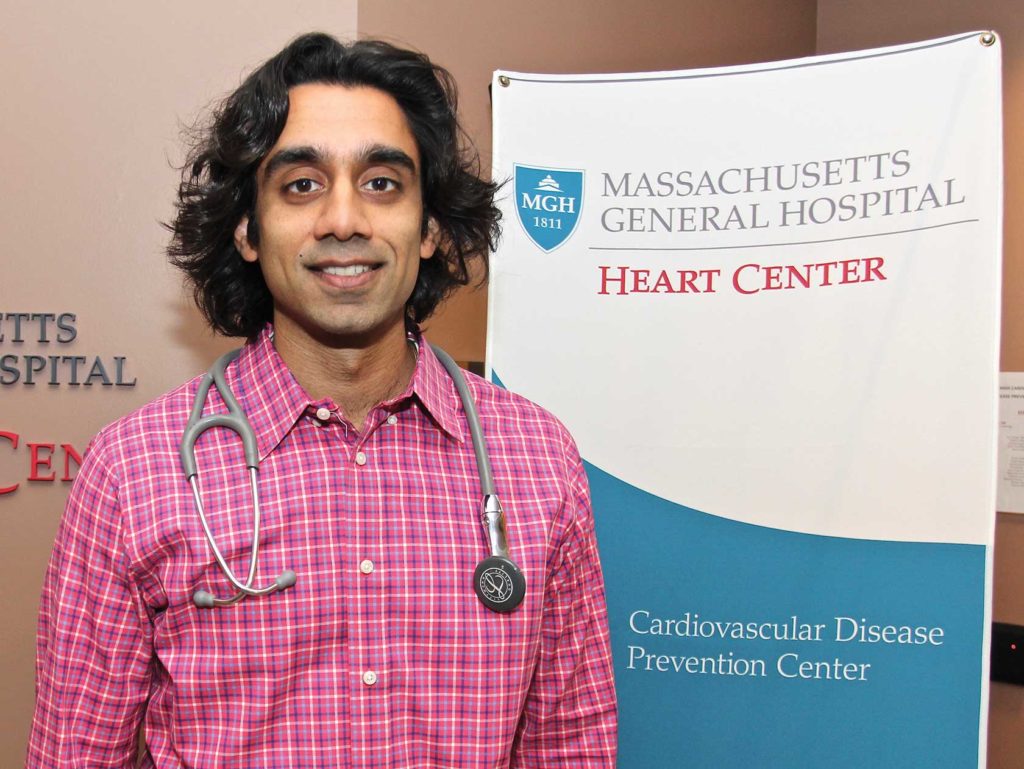
The heart has a pretty big job. It feeds the entire body. With every beat it distributes life-saving oxygen and nutrients to vital organs and muscles.
It beats about 100,000 times a day and 35 million times a year.
You would think that with such a large responsibility, the heart must be pretty hefty. Actually, it doesn’t even weigh a pound. It’s about the size of a fist, and can fit snugly in the palm of your hand.
Clearly, size does not matter.
It might sound incongruous, but In order to pump blood, the heart needs a supply itself. Four major arteries feed the heart. But if the blood is blocked, a heart attack can ensue.
An invisible enemy
Without warning atherosclerosis or plaque, a composition of cholesterol, white blood cells, calcium and other inflammatory substances, can build up in the walls of the arteries. “The process for plaque formation starts early in life,” explained Dr. Pradeep Natarajan, the Director of Preventive Cardiology at Massachusetts General Hospital. “Healthy behaviors early in life are important.”
The best way to determine if a person has plaque buildup is assessment of risks. A doctor will check cholesterol, blood pressure, glucose for diabetes, weight and smoking history. Age and family history are key as well. Your risk is increased if a first-degree relative, such as a parent or sibling, had a heart attack before the age of 55 if male and 65 if female. African Americans are hit hard largely due to the high prevalence of diabetes, hypertension and obesity.
In some instances, however, a heart scan is a better tool to detect and measure plaque in the arteries. A score greater than 400 is a sign of very high to severe heart disease and heart attack risk, according to the American Journal of Cardiology.
The mere existence of plaque is not necessarily a threat. If it ruptures, however, a blood clot can form, and if of formidable size, obstructs the flow of blood to the heart.
This is a heart attack, or myocardial infarction.
The impacted section begins to die and will result in permanent damage if not quickly treated.
Different types
Not all heart attacks are alike. The blockage can be partial or complete. One or more arteries may be affected. Plaque is not the culprit in all cases. Spasms caused by illicit drug use, such as cocaine, can impede the blood flow.
Some attacks go unnoticed. The victim doesn’t even know it has occurred. These are called silent heart attacks. People with diabetes tend to fall into this category. Their ability to feel pain is often reduced due to damage to the nervous system. That’s not a good thing since diabetes on its own is a major risk factor for heart disease.

During a heart attack, a blockage, usually caused by plaque, reduces or prevents blood flow in one or more arteries. If treatment is delayed, that section of the heart begins to die, and can result in permanent damage.
Used with permission of Mayo Foundation for Medical Information and Research, all rights reserved
Unrecognized symptoms
Someone has a heart attack every 40 seconds, according to the American Heart Association. It is not surprising then that it is the leading cause of death in this country. Uncontrolled risk factors are the chief cause, but there is another.
People often do not recognize the symptoms of a heart attack. A study published by the Centers for Disease Control and Prevention found that only 50% of those interviewed were familiar with the five common heart attack symptoms. Lack of recognition was more common in minorities and those less educated. You can thank TV and Hollywood for that.
The typical depiction is a man clutching his chest and left arm while staggering to the ground. Such symptoms do occur, but most often they’re more subtle. That’s part of the problem. People often mistake their symptoms for lack of sleep, overwork or indigestion and reach for the Tums instead of 911.
The most common symptoms are pressure or tightness in the chest, nausea, dizziness, pain in the neck, jaw or back, or shortness of breath. Sometimes they subside, then return. Some attacks are immediate, while others develop more slowly over a matter of days.
Natarajan offers some pointers. New and persistent are the key words. “Be aware of any pain in the chest, especially if it’s new and persistent, he explained. And it’s not just chest pain. “Persistent discomfort, shortness of breath, indigestion that does not go away with rest are all symptoms.”
Signs and symptoms
• Chest pain or discomfort
• Lightheadedness or feeling faint
• Pain or discomfort in the jaw, neckor back
• Pain or discomfort in arm or shoulders
• Shortness of breath
• Unusual or unexplained fatigue
• Nausea or vomiting
• Cold sweat
Risk factors
Some risk factors of a heart attack
are beyond our control:
• Age: increases with age
• Race: more common in Blacks
• Gender: more common in males
• Family history
Others aren’t:
• Blood pressure
• Cholesterol
• Triglycerides
• Weight
• Diet
• Tobacco and alcohol use
• Exercise
What’s your number? An important baseline
Screening tests help determine if you are at risk for a heart attack. The recommended readings may differ for those with a history of coronary heart disease or diabetes.
Risk Factor: Blood pressure Recommended Reading: <120/80
Risk Factor: Diabetes Recommended Reading: Glucose<140 • A1C<5.7
Risk Factor: Lipid Panel Recommended Reading: Total cholesterol <200 • HDL >40 in men >50 in women • LDL <100 • Triglycerides <150
Risk Factor: Body Mass Index (BMI) Recommended Reading: 18.5–24.9
Source: Mayo Clinic
Act fast
If you have any of these symptoms, call 911 immediately. Emergency medical services not only begins treatment in your home, but also initiates communication directly with a hospital to ensure timely intervention.
Take an aspirin if it does not interact with other medications. “Take one adult aspirin or four baby aspirins,” explained Natarajan. Aspirin is a blood thinner and slows clotting.
Do not drive yourself to the hospital. Your symptoms can deteriorate en route. Even worse, although not common, heart attacks can cause a cardiac arrest. Fewer than 10% of these cases that occur out of hospital survive.
The American College of Cardiology and American Heart Association have established guidelines called “door to balloon time,” which refers to a 90-minute window of time to reopen arteries for best patient outcomes following a heart attack. If you drive yourself, registration and delays in the emergency room can result in failure to meet the guidelines.
Diagnosis and treatment
Several tests are used to confirm a heart attack.
An EKG, or electrocardiogram detects damage in the heart and shows if it is beating normally. A blood test looks for a protein called troponin that is elevated when the heart muscle becomes damaged.
An invasive test called catheterization uses dye and an x-ray to look inside the heart for possible blockages.
Depending on the extent of the damage, three different treatments may be offered. Medication called a clot buster will dissolve the blood clot causing the obstruction. Angioplasty is a minimally invasive procedure. A small balloon is inflated at the blockage to increase blood flow. A stent is often placed to keep the artery open once the balloon is deflated and removed.
More involved cases, however, may require surgery called coronary artery bypass graft, or CABG, during which vessels from the leg or chest are used to route blood around the blockages.
Prevention
The best treatment, however, is prevention. Keep your weight down, eat healthy foods, don’t smoke, take a walk. Heart attacks are largely avoidable with healthy lifestyles. Manage your blood pressure, cholesterol and glucose. If you have unfortunately suffered a heart attack, take steps then to avoid another.
You are born with one heart. It is programmed to keep pumping to keep you alive, but to do that, it needs a little help from you.







